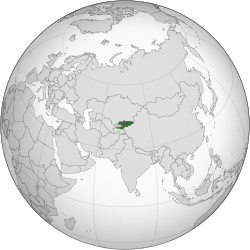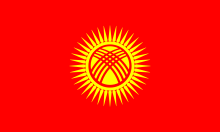ڪرغزستان
ڪرغز ريپبلڪ Kyrgyz Republic Кыргыз Республикасы (ڪرغز) Кыргызская Республика (روسی) | |||||
|---|---|---|---|---|---|
| |||||
ترانو: Кыргыз Республикасынын
Мамлекетти гимник
(ڪرغز) | |||||
 ڪرغزستان جو مقام (سائو) | |||||
| گادي جو هنڌ | بشڪيڪ 42°52′N 74°36′E / 42.867°N 74.600°E | ||||
| سڀ کان وڏو شهر | گاديء وارو شھر | ||||
| دفتري ٻوليون |
| ||||
| آفیشل لکائی | سائیریلڪ | ||||
| بولیون |
| ||||
| نسلي گروھ (2023[2]) |
| ||||
| مذهب (2021) |
| ||||
| مقامي آبادي | ڪرغيز ڪرغزستاني[3] | ||||
| حڪومت | گڏيل صدارتي جمهوريہ | ||||
• صدر |
صدر جاپاروف | ||||
• وزيرن جي ڪابينا جو چيئرمين |
اڪيل بيڪ جاپاروف | ||||
• سپريم ڪائونسل جو اسپيڪر |
نرلان۔بيڪ شاڪیف | ||||
| مقننه | سپريم ڪائونسل | ||||
| ٺهڻ جي تاريخ | |||||
• ينيسي۔ڪرغيز خاقانات
[4] |
693ع | ||||
• روسي سلطنت طرفان الحاق |
1876ع | ||||
• ڪارا-ڪرغز خودمختیار اوبلاسٽ |
14 آڪٽوبر، 1924ع | ||||
• ڪرغز خودمختيار ايس ايس آر |
11 فيبروري، 1926ع | ||||
• ڪرغز ايس ايس آر |
5 ڊسمبر 1936ع | ||||
• خودمختاري جو اعلان ڪيو ويو |
30 ڊسمبر 1990 | ||||
• يو ايس ايس آر (روس) کان آزادي جو اعلان |
31 آگسٽ 1991 | ||||
• آزادي تسليم ڪئي وئي |
26 ڊسمبر 1991 | ||||
• موجوده آئين |
11 اپريل، 2022 | ||||
| پکيڙ | |||||
• جملي |
[اوزا تبديل: invalid number] (85th) | ||||
• پاڻي |
7٬198 km2 (2٬779 sq mi) | ||||
• پاڻي (%) |
3.6 | ||||
| آبادي | |||||
• 2023 اندازو |
7,037,590[6] (112th[6]) | ||||
• گھاٽائي |
27.4 /km2 (71.0 /sq mi) (109th) | ||||
| جِي ڊي پي (مساوي قوت خريد ) | 2024 لڳ ڀڳ | ||||
• ڪل |
|||||
• في سيڪڙو |
|||||
| جِي. ڊي. پي (رڳو نالي ۾ ) | 2024 لڳ ڀڳ | ||||
• ڪل |
|||||
ڪِرغزستان (ڪرغیز: Кыргызстан)، سرڪاري طور تي ڪرغز ريپبلڪ، وچ ايشيا ۾ هڪ زميني بند ملڪ آهي، جيڪو تيان شان ۽ پامير جبلن جي قطارن ۾ واقع آهي. بشڪيڪ ملڪ جو گاديءَ جو هنڌ ۽ سڀ کان وڏو شهر آهي. ڪرغزستان جي سرحد اتر ۾ قزاقستان، اولهه ۾ ازبڪستان، ڏکڻ ۾ تاجڪستان ۽ اوڀر ۽ ڏکڻ۔اوڀر ۾ چين سان لڳل آهي. نسلي ڪرغز ملڪ جي ستر لک ماڻهن جي اڪثريت تي مشتمل آهي، جنهن جي پٺيان ازبڪ ۽ روسي اهم اقليتون آهي.
ڪرغزستان جي تاريخ مختلف ثقافتن ۽ سلطنتن تي مشتمل آهي. جيتوڻيڪ جغرافيائي طور تي ان جي انتهائي جبلن واري علائقي کان الڳ آهي، ڪرغزستان ٻين تجارتي رستن سان گڏ سلڪ روڊ جي حصي جي طور تي ڪيترن ئي عظيم تمدن جي سنگم تي آهي. قبيلن ۽ قبيلن جي هڪ جانشين سان آباد، ڪرغزستان وقتي طور تي وڏي تسلط هيٺ اچي ويو آهي، مثال طور ترڪ خانہ بدوش، جيڪي ڪيترن ئي ترڪ رياستن ڏانهن پنهنجون نسلون ڄاڻن ٿا. اهو پهريون ڀيرو ینیسی ڪرغز خاقانیت طور قائم ڪيو ويو. بعد ۾، 13ھین صدي عيسويء ۾، ڪرغزستان منگول طرفان فتح ڪيو ويو؛ ان کي ٻيهر آزادي ملي، پر بعد ۾ زونگر خانات طرفان حملو ڪيو ويو. زونگارن جي زوال کان پوءِ ڪرغز ۽ ڪپچاڪ ڪوڪند خانات جو لازمي حصو هئا. سال 1876ع ۾، ڪرغزستان روسي سلطنت جو حصو بڻجي ويو، ۽ سال 1936ع ۾، ڪرغز سوويت سوشلسٽ ريپبلڪ کي سوويت يونين جي هڪ آئيني جمهوريه بنائڻ لاء ٺهيل هئي. سوویت یونین ۾ ميخائل گورباچوف جي جمهوري سڌارن جي پٺيان، سال 1990ع ۾ آزاديءَ جو حامي اميدوار عسڪر اڪيف صدر چونڊيو ويو. 31 آگسٽ، 1991ع تي، ڪرغزستان سوویت یونین کان آزادي جو اعلان ڪيو ۽ هڪ جمهوري حڪومت قائم ڪئي وئي. سال 1991ع ۾ سوويت يونين جي ٽٽڻ کان پوءِ ڪرغزستان هڪ قومي رياست جي حيثيت سان خودمختياري حاصل ڪئي.
Kyrgyzstan,[lower-alpha 1] officially the Kyrgyz Republic,[lower-alpha 2][12] is a landlocked country in Central Asia, lying in the Tian Shan and Pamir mountain ranges. Bishkek is the capital and largest city of the country. Kyrgyzstan is bordered by Kazakhstan to the north, Uzbekistan to the west, Tajikistan to the south, and China to the east and southeast.[13][14][15] Ethnic Kyrgyz make up the majority of the country's 7 million people, followed by significant minorities of Uzbeks and Russians.[16]
Kyrgyzstan's history spans a variety of cultures and empires. Although geographically isolated by its highly mountainous terrain, Kyrgyzstan has been at the crossroads of several great civilizations as part of the Silk Road along with other commercial routes. Inhabited by a succession of tribes and clans, Kyrgyzstan has periodically fallen under larger domination, for example the Turkic nomads, who trace their ancestry to many Turkic states. It was first established as the Yenisei Kyrgyz Khaganate. Later, in the 13th century, Kyrgyzstan was conquered by the Mongols; it regained independence, but was later invaded by the Dzungar Khanate. After the fall of Dzhungars, Kyrgyz and Kipchaks were an integral part of Kokand Khanate. In 1876, Kyrgyzstan became part of the Russian Empire, and in 1936, the Kirghiz Soviet Socialist Republic was formed to become a constituent republic of the Soviet Union. Following Mikhail Gorbachev's democratic reforms in the USSR, in 1990 pro-independence candidate Askar Akayev was elected president. On 31 August 1991, Kyrgyzstan declared independence from the USSR and a democratic government was established. Kyrgyzstan attained sovereignty as a nation state after the breakup of the Soviet Union in 1991.

After independence, Kyrgyzstan was officially a unitary presidential republic; after the Tulip Revolution it became a unitary parliamentary republic, although it gradually developed an executive president and was governed as a semi-presidential republic before reverting to a presidential system in 2021. Throughout its existence, the country has continued to endure ethnic conflicts,[17][18] revolts,[19] economic troubles,[20][21] transitional governments[22] and political conflict.[23]
Kyrgyzstan is a member of the Commonwealth of Independent States, the Eurasian Economic Union, the Collective Security Treaty Organization, the Shanghai Cooperation Organisation, the Organisation of Islamic Cooperation, the Organization for Security and Cooperation in Europe, the Organisation of Turkic States, the Türksoy community and the United Nations. It is a developing country ranked 118th in the Human Development Index, and is the second poorest country in Central Asia after neighbouring Tajikistan. The country's transitional economy is heavily dependent on deposits of gold, coal and uranium.

حوالا[سنواريو]
- ↑ "Kyrgyzstan's Constitution of 2010 with Amendments through 2016" (PDF). Constitute Project. حاصل ڪيل 2 September 2020.
- ↑ "Statistical Yearbook of the Kyrgyz Republic - Publications Archive - Statistics of the Kyrgyz Republic".
- ↑ "Definition of Kyrgyzstani noun from the Oxford Advanced American Dictionary". Oxford Learner's Dictionaries. Oxford University Press.
- ↑ "History of Central Asia". Encyclopædia Britannica. حاصل ڪيل 12 March 2021.
- ↑ https://www.vb.kg/doc/424615_bezyslovno_eto_pobeda_ploshad_kyrgyzstana_dostigla_20_mln_gektarov.html
- ↑ 6.0 6.1 "Это мальчик! В Кыргызстане родился семимиллионный житель".
- ↑ "World Economic Outlook Database, March 2024 Edition. (Kyrgyzstan)". IMF.org. International Monetary Fund. حاصل ڪيل 18 October 2023.
- ↑ 8.0 8.1 "World Economic Outlook Database, October 2023 Edition. (Kyrgyzstan)". IMF.org. International Monetary Fund. حاصل ڪيل 18 October 2023.
- ↑ "2021 Report on International Religious Freedom: Kyrgyz Republic". United States Department of State. حاصل ڪيل 2022-09-18.
- ↑ "GINI index (World Bank estimate) - Kyrgyz Republic". data.worldbank.org. World Bank. حاصل ڪيل 26 September 2022.
- ↑ "Human Development Report 2023/2024" (PDF). United Nations Development Programme. وقت 13 March 2024 تي اصل (PDF) کان آرڪائيو ٿيل. حاصل ڪيل 13 March 2024. Unknown parameter
|url-status=ignored (مدد) - ↑ Article 1 of the Constitution of the Kyrgyz Republic states: "1. Kyrgyzstan (Kyrgyz Republic)...". "2021-жылдын 5-майындагы Кыргыз Республикасынын Конституциясы (2021-жылдын 11-апрелиндеги референдумда (бүткүл элдик добуш берүүдө) кабыл алынган".
- ↑ "Constitution of the Kyrgyz Republic". CIS Legislation. حاصل ڪيل 31 December 2021.
- ↑ "Kyrgyzstan Constitution" (PDF). Constitution Net. حاصل ڪيل 31 December 2021.
- ↑ "Constitution of the Kyrgyz Republic" (PDF). Legislationline. وقت 21 January 2022 تي اصل (PDF) کان آرڪائيو ٿيل. حاصل ڪيل 31 December 2021. Unknown parameter
|url-status=ignored (مدد) - ↑ "Total population by nationality - Open Data - Statistics of the Kyrgyz Republic". stat.kg. حاصل ڪيل 2023-02-07.
- ↑ "Investigating Kyrgyzstan's ethnic violence: Bloody business". The Economist. 12 May 2011. http://www.economist.com/node/18682522.
- ↑ "Foreigners in Kyrgyzstan: 'Will We Be Banned, Too?'". Eurasianet (EurasiaNet.org). 15 June 2011. http://www.eurasianet.org/node/63678.
- ↑ "Pro-Government Election Victory Sparks Overnight Revolution in Kyrgyzstan". OCCRP. حاصل ڪيل 10 November 2020.
- ↑ "Kyrgyzstan: Economy globalEDGE: Your source for Global Business Knowledge". Globaledge.msu.edu. حاصل ڪيل 26 March 2013.
- ↑ "Kyrgyz Republic Economy: Population, GDP, Inflation, Business, Trade, FDI, Corruption". Heritage.org. وقت 25 February 2021 تي اصل کان آرڪائيو ٿيل. حاصل ڪيل 26 March 2013. Unknown parameter
|url-status=ignored (مدد) - ↑ "BBC News – Kyrgyzstan profile – Timeline". Bbc.co.uk. حاصل ڪيل 26 March 2013.
- ↑ "Kyrgyz Unrest". EurasiaNet.org. حاصل ڪيل 26 March 2013.
حوالي جي چڪ: "lower-alpha" نالي جي حوالن جي لاءِ ٽيگ <ref> آهن، پر لاڳاپيل ٽيگ <references group="lower-alpha"/> نہ مليو
- اھي صفحا جيڪي سانچن جي سڏن ۾ ٻٽيون شيون استعمال ڪن ٿا
- غيرمددي پيراميٽر سان حوالا تي مشتمل صفحا
- مضمون with short description
- Short description is different from Wikidata
- سانچو تبديل جا نادرست اختيار
- اڻ تصديق ٿيل دعوائن وارا مضمون
- اڻ تصديق ٿيل دعوائن وارا مضمون از April 2024
- جاگرافي
- ايشيا
- ملڪ
- ايشيا ۾ ملڪ
- وچ ايشيا جا ملڪ
- ڀونءِ گھيريل ملڪ
- ڪِرگزِستانُ
- ڀونءِ ڀياس ۽ ڀونءِ نگاري
- 1991 ايشيا ۾ ادارا
- آزاد رياستن جي ڪامن ويلٿ جون ڀاتي رياستون
- گڏيل قومن جا ڀاتي ملڪ
- روسي-ڳالهائيندڙ ملڪ ۽ علائقا
- 1991 ۾ ٺاهيل رياستون ۽ علائقا
- حوالن ۾ چُڪَ وارا صفحا


